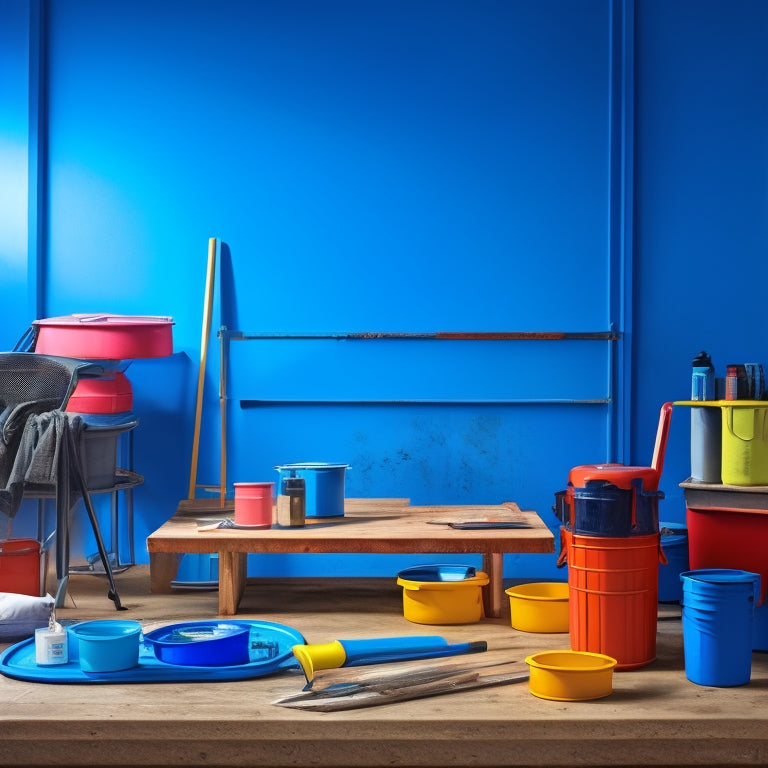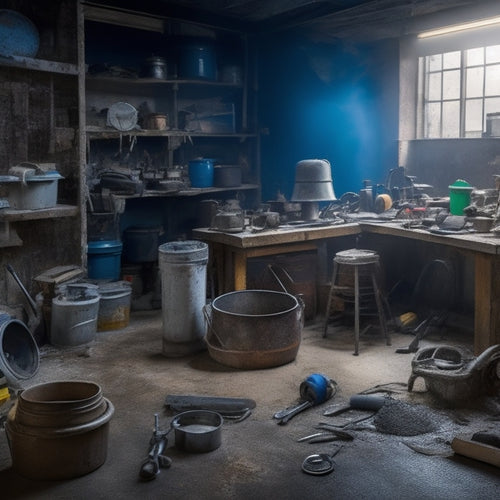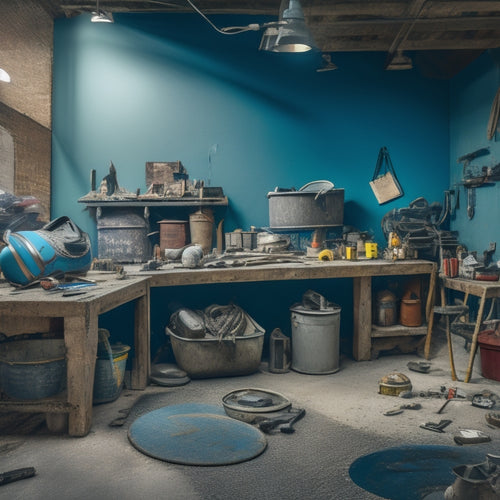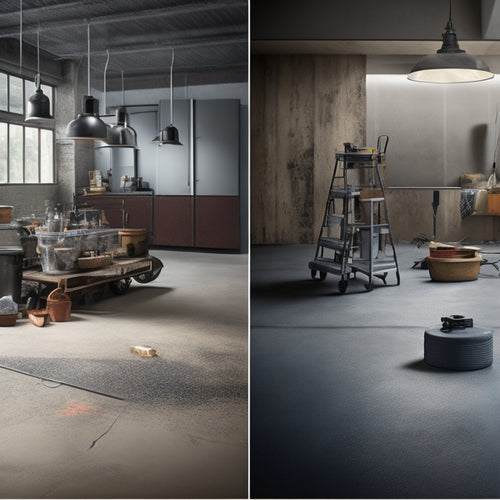
Top 5 Tools for Concrete Paint Application
Share
When painting concrete, you'll need the right tools to achieve a professional-looking finish. You'll want to invest in essential brushes with the right bristle material, length, and density for your desired finish. Rollers will help you cover large surfaces efficiently, while sprayers guarantee consistent coats. Don't forget scrapers for thorough surface preparation and trays for organized paint handling. By combining these top 5 tools, you'll be well on your way to a successful project. Now, discover how to maximize their potential and take your concrete paint application to the next level.
Key Takeaways
• For a smooth finish, use synthetic-bristle brushes, and for textured finishes, use natural-bristle brushes, considering brush length and density.
• Microfiber or foam rollers are ideal for smooth surfaces, while lint-free or wool rollers suit rough textures, ensuring efficient coverage.
• Choose the right sprayer type (airless, HVLP, or electric) for your paint's viscosity, and follow manufacturer instructions for a consistent coat.
• Scrapers are essential for surface preparation, removing old layers, and ensuring a clean surface; select scrapers compatible with your surface type.
• Invest in a quality paint tray with organizational features, such as grids and compartments, to minimize drip and spill and enhance work efficiency.
Essential Brushes for Smooth Finishes
When selecting the right brushes for a smooth concrete paint finish, you're choosing between a variety of bristle materials, lengths, and densities that directly impact the final appearance of your project.
For a high-gloss finish, you'll want to opt for brushes with synthetic bristles, which produce a smooth, even application. Natural bristle brushes, on the other hand, are better suited for textured finishes and can add a unique character to your concrete surface.
When it comes to brush lengths, shorter brushes are ideal for cutting in and painting small, intricate areas, while longer brushes are better for covering larger surfaces. Brush density also plays a significant role, with denser brushes holding more paint and producing a thicker coat.
By selecting the right brush type and finish technique, you can achieve a professional-looking finish that showcases your concrete surface. Whether you're looking for a sleek, modern look or a more rustic, textured appearance, the right brush can make all the difference.
Rollers for Efficient Coverage
You'll markedly speed up your concrete paint application process by incorporating rollers into your toolkit, which are specifically designed to efficiently cover large surfaces with minimal effort.
When choosing the right roller, consider the surface texture and paint type. For smooth surfaces, use a microfiber or foam roller, which will provide an even, streak-free finish. For rougher surfaces, opt for a lint-free or wool roller, which can handle thicker paint and more textured concrete.
Mastering roller techniques is also essential for efficient coverage. Work in sections, dividing the surface into manageable areas to maintain even coverage. Use long, smooth strokes to apply the paint, maintaining consistent pressure and speed.
For larger areas, use a 'W' or 'M' pattern to guarantee thorough coverage. Don't overload the roller with too much paint, as this can lead to drips and unevenness.
Sprayers for Consistent Coats
Sprayers for Consistent Coats
Selecting the right sprayer for your concrete paint application guarantees a uniform, consistent coat, and with the right technique, you can achieve a professional-looking finish without the hassle of rollers or brushes. When choosing a sprayer, consider the type of paint you're using, as different sprayers are designed for specific paint viscosities.
| Sprayer Type | Suitable for Paint Viscosity |
|---|---|
| Airless Sprayer | High to Medium Viscosity |
| HVLP Sprayer | Low to Medium Viscosity |
| Electric Sprayer | Low Viscosity |
Airless sprayers are ideal for high-viscosity paints, while HVLP sprayers work best with low-to-medium viscosity paints. Electric sprayers are perfect for low-viscosity paints. By selecting the right sprayer for your paint, you'll achieve a smooth, even coat that enhances the appearance of your concrete surface. Remember to always follow the manufacturer's instructions and take necessary safety precautions when using a sprayer. With the right sprayer and technique, you'll be able to achieve a beautiful, professional-looking finish that adds value to your property.
Scrapers for Surface Preparation
Before applying a fresh coat of concrete paint, scrape away old, flaking layers with the right scraper to guarantee a strong bond between the new paint and the surface.
You'll need a scraper that can effectively remove dirt, grime, and old paint without damaging the concrete. A high-quality scraper will allow you to achieve a smooth, even surface, perfect for painting.
When choosing a scraper, evaluate the type of concrete you're working with and the level of surface cleaning required. A stiff scraper is ideal for rough, textured surfaces, while a flexible scraper is better suited for smooth surfaces. You may also want to think about a scraper with adjustable blades, allowing you to customize the angle and depth of the scrape.
Proper surface preparation is essential for a successful paint job. By scraping away imperfections and old paint, you'll create a surface that's ready for texture enhancement and painting.
With the right scraper, you'll be able to achieve a professional-looking finish that will last for years to come. So, don't skip this vital step – invest in a high-quality scraper and get ready to transform your concrete surface.
Trays for Organized Paint Handling
When it comes to painting concrete surfaces, a well-organized paint handling system is essential, and that's where high-quality paint trays come into play. You'll want to invest in a tray that's designed for efficient paint tray organization, allowing you to work freely without the hassle of mess and waste.
When choosing a paint tray, consider the material it's made of. You have options like stainless steel, plastic, and fiberglass. Each has its pros and cons. Stainless steel trays are durable and resistant to rust, but they can be heavy and expensive. Plastic trays are lightweight and affordable, but they may not be as sturdy. Fiberglass trays offer a balance between the two, providing durability and affordability.
In terms of paint tray organization, look for features like built-in grids, compartments, and handles. These will help you keep your paint and tools organized, making it easier to work efficiently. A well-designed paint tray will also prevent paint from dripping and spilling, saving you time and effort in the long run.
Frequently Asked Questions
Can I Use a Single Tool for Both Primer and Topcoat Application?
When applying primer and topcoat, you might wonder if you can use a single tool for both.
The answer lies in tool versatility and application techniques. While it's technically possible, it's not always the most effective approach.
Different tools are designed for specific tasks, and using one for both can compromise results.
However, if you're looking for freedom in your process, consider a high-quality, adaptable tool that can handle both tasks with precision and control.
How Often Should I Clean My Concrete Paint Application Tools?
You might think, 'I'm too busy to clean my tools after every use,' but trust us, it's worth it.
Regular tool maintenance is essential to guarantee a smooth, even application. You should clean your tools daily, or at least after every project, to prevent paint buildup.
This cleaning frequency will save you time and frustration in the long run, giving you the freedom to focus on your next project.
Are There Any Specific Safety Precautions for Concrete Paint Application?
When applying concrete paint, you'll want to prioritize safety above all.
Make sure you're working in a well-ventilated area to avoid inhaling harmful fumes.
Wear personal protective equipment like gloves, goggles, and a mask to shield yourself from skin and eye irritation.
Don't take shortcuts – these ventilation measures and safety gear are essential to protecting your health and freedom to create.
Can I Apply Concrete Paint in Extreme Weather Conditions?
When you're planning to apply concrete paint, consider the weather conditions.
You shouldn't apply paint in extreme temperatures, above 90°F (32°C) or below 50°F (10°C), as it can affect the paint's adhesion and drying time.
Additionally, high humidity can lead to uneven finishes and prolonged drying times.
You'll get the best results when you apply paint in moderate temperatures and humidity levels, ensuring a smooth, even finish that lasts.
Do I Need to Prime the Concrete Surface Before Painting?
'Cut to the chase' - when it comes to painting concrete, you can't skip the prep work.
You absolutely need to prime the surface before painting. Proper surface preparation is key to a durable, long-lasting finish.
You'll want to choose the right primer type for your concrete surface, whether it's epoxy, acrylic, or silane.
Don't take shortcuts - prime first, and you'll be on your way to a beautiful, freedom-filled finish that will stand the test of time.
Conclusion
You've got the right tools in your toolbox, and now it's time to put them to work.
Remember, a successful concrete paint application is like conducting a symphony - each tool plays an essential role in creating a harmonious finish.
By mastering these top 5 tools, you'll be the maestro of a beautifully painted concrete surface.
With the right brushes, rollers, sprayers, scrapers, and trays, you'll be well on your way to a flawless, professional-looking finish that will make your project sing.
Related Posts
-

7 Tools to Fix Damaged Concrete Floors
You're about to tackle that damaged concrete floor, and the right tools are essential for a successful repair. Start ...
-

What Tools Do You Need for Concrete Flooring
You'll need a thorough arsenal of specialized tools to achieve a high-quality, professional-looking concrete floor, i...
-

Top Tools for Revamping Old Concrete Floors
You'll need a range of tools to revamp your old concrete floor, starting with epoxy, acrylic, or polyurethane paint, ...


